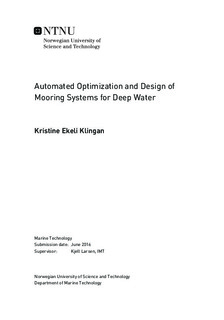Automated Optimization and Design of Mooring Systems for Deep Water
Master thesis
Date
2016Metadata
Show full item recordCollections
- Institutt for marin teknikk [3397]
Abstract
This master thesis focuses on automated optimization of mooring systems at deep water. The optimizationwork is based on the mooring system of the deep draft semisubmersible DEMO2000 developed by Statoil.This is a semisubmersible with mooring system designed for 1500 m water depth. The automated optimizationalgorithm implemented in the simulation software SIMA, developed by Marintek, is used for theoptimization. This automated optimization algorithm is not yet commercialized, and the work performedin this thesis can be seen as part of a pilot study.
Mathematically, optimization of a mooring system is the minimization of a cost function subjected to constraintson its variables. Hence, automated optimization algorithms refer to the application ofmathematicalsearch algorithms in this optimization process. A collection of optimization algorithms is available. SIMAhowever, uses a subsequential quadratic programming method algorithm called NLPQLP.
The optimization is carried out for amaximumdesign condition based on metocean data formthe Heidrunfield. The environment is applied in-line propagating from Northeast with a combination of wind, wavesand current in accordance with the requirements for the Norwegian continental shelf.
The optimization problem for this thesis is defined based on a cost function, variables and constraints. Themooring line is constructed of three segments, for each of these segments the diameter and length is definedas variables. In addition, the pretension of the mooring line is set as a variable. This allows the anchorpositions to change during the optimization. The cost function is based on the price of each mooring linesegment, which again depends on length and diameter. Two constraints are included in the optimization.The first constraint concerns the safety factor of the most loaded mooring line, while the second restricts themaximum offset of the semisubmersible in the direction of the environmental loading. The optimizationproblem is formulated in terms of workflows in SIMA workbench, and the optimization is carried out in thetime domain using SIMO.
Three optimization cases are defined. The first case is the base case that requires a safety factor of 2.2 and amaximum offset of 150 m. The second case requires a safety factor of 1.8 and a maximum offset of 150 m,while the third case requires a safety factor of 2.2 and a maximum offset of 75m.
Two different mooring systems, based on the mooring system provided by Statoil, are optimized separatelyfor all three cases. One mooring system is constructed of polyester rope and chain, while the other is constructed of steel wire rope and chain. The results of the optimization cases and relevant sensitivity studiesshow that the cost may be reduced significantly by use of the automated optimization algorithm.
For the polyester rope and chain mooring system, the constraint concerning safety factor is observed todominate the optimization. The difference in cost for the first and third case is therefore small, while thecost for the second case is significantly lower. The second case does also provide the lowest cost for thesteel wire rope and chain mooring system. However, both constraints influence the optimization of this system.The third case is therefore observed to result in much higher cost compared to the two other cases.Compared to the initial system the cost of the polyester rope and chain mooring system for the base case isreduced by 29.4 %, while the cost of the steel wire rope and chain mooring system for the base case is reducedby 19.3 % compared to the initial mooring system of this type. However, the polyester rope and chainmooring system is observed to provide the lowest cost.
As the optimization algorithm only consider the cost of the mooring system, the maximum and minimumvalues of the variables need to be chosen carefully. Both optimized mooring system tend to have unrealisticlowpretension, which indicates that the minimumvalue for the pretensionwas too low. The chain segmentsare also very short for the optimized systems, as chain is the most expensivemooring line material included.Polyester rope and steel wire rope is therefore close to having contact with seafloor for the optimized mooringsystems at maximum offset.
Dynamic analyzes of the tension in the most loaded line for both mooring systems are performed usingRIFLEX. The top end motions calculated in SIMO are for these analyzes imported to RIFLEX. Analyzes ofthe mooring system in the frequency domain using MIMOSA is also performed. For the polyester rope andchain mooring system only small differences are observed for the quasi-static and dynamic analysis results.The dynamic effects are neglectable for this system as the elongation of the mooring line dominates thestiffness. The differences in the results of the analysis performed in time domain and in frequency domainis also very small, indicating that the linearization performed in the frequency domain analysis have close tono impact on the top end tension. For the steel wire rope and chain mooring system, large dynamic effectsare observed. This is as expected as mooring lines in a catenary system will have a lot of lateral movement.The large water span will also influence these effects. Differences are also observed in the results from thecalculation in the frequency domain and the time domain. Hence, the linearization in the frequency domainwill affect the top tension remarkably.
